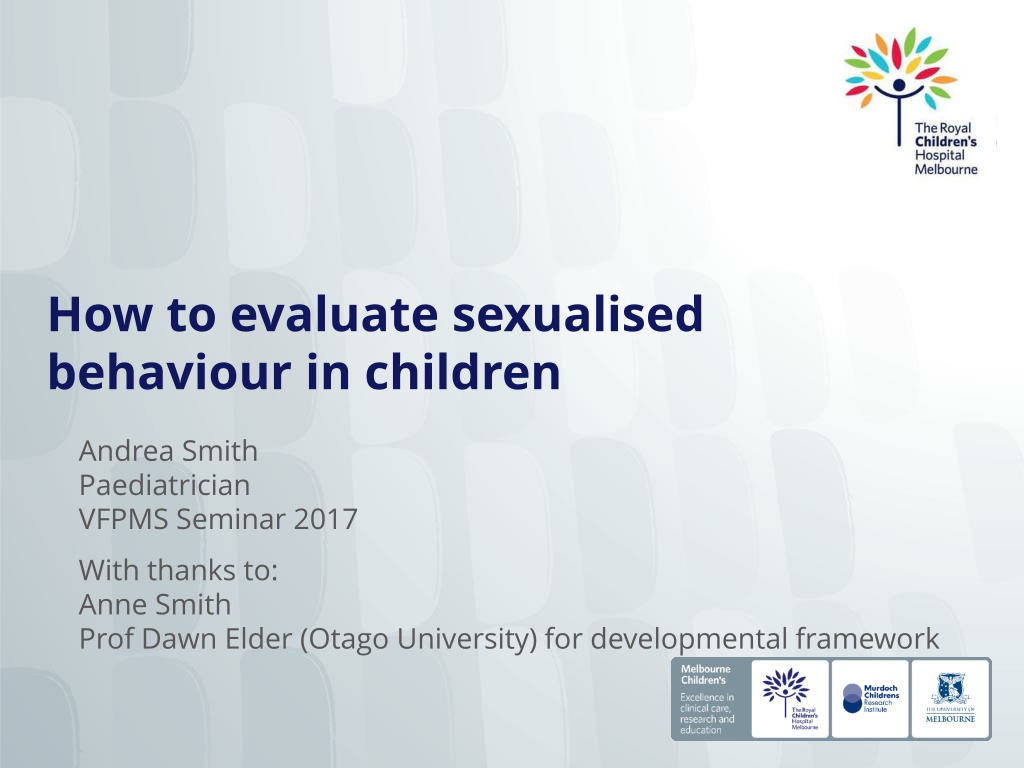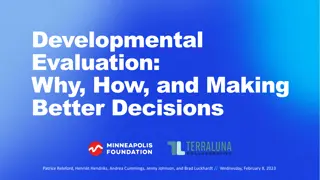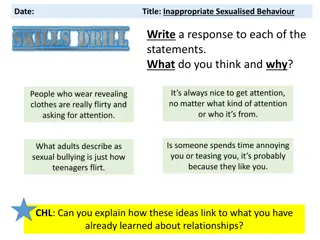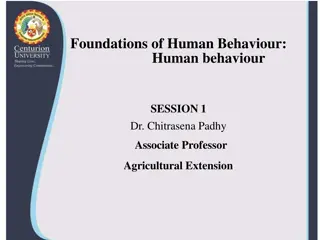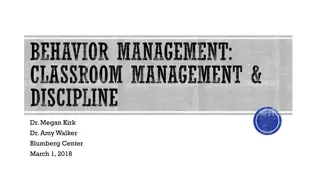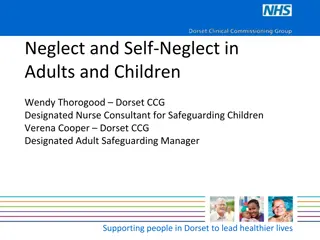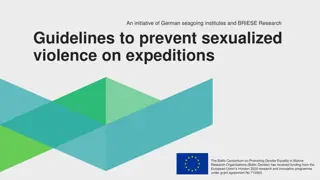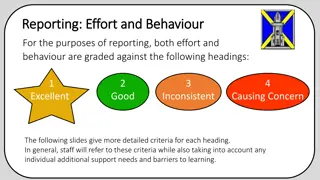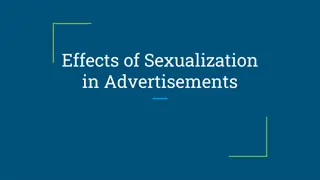Understanding Sexualized Behavior in Children: Evaluation and Development
Evaluating sexualized behavior in children involves considering normal development, situational and environmental factors, abuse sequelae, and neurodevelopmental problems. There is no fixed definition of sexualized behavior due to varying contexts, age-appropriate norms, and cultural influences. Common sexualized behaviors in children include exploration, curiosity, and relationship building. Sexual development progresses from genital self-exploration to awareness of gender differences as children grow.
Download Presentation

Please find below an Image/Link to download the presentation.
The content on the website is provided AS IS for your information and personal use only. It may not be sold, licensed, or shared on other websites without obtaining consent from the author. Download presentation by click this link. If you encounter any issues during the download, it is possible that the publisher has removed the file from their server.
E N D
Presentation Transcript
How to evaluate sexualised behaviour in children Andrea Smith Paediatrician VFPMS Seminar 2017 With thanks to: Anne Smith Prof Dawn Elder (Otago University) for developmental framework
Sexualised behaviour: 4 key associations NORMAL DEVELOPMENT Sexualised behaviour SITUATIONAL ENVIRONMENTAL FACTORS ABUSE SEQUELAE NEURO DEVELOPMENTAL PROBLEMS (incl ASD)
What IS sexualised behaviour? How is it defined? THERE IS NO ACCEPTED DEFINITION What is the context? Are there age appropriate norms? Are there cultural norms? Who diagnoses it? How is it evaluated?
Common sexualised behaviours (all children) Looking Sneaking a glance you show me yours and I ll show you mine Touching rubbing, inserting Copying witnessed behaviour Comforting / Arousing self Arousing others Involve exploring bodies, gender roles and behaviours Curiosity Exploration / experimentation Sensuality Awareness of sexuality (~ cognitive development) Relationship building Pathway towards increasing intimacy
Sexual Development: 0 - 2 years Capacity for male erection / female lubrication / orgasm Genital self-exploration and stimulation, boys more so Insertion of objects into orifices Learn & name body parts Vulva: vagina, gina, fanny, minnie, pee pee, private part, tuk tuk, birdie, bum Penis: penis, dick, doodle, noodle, pee pee, private part, wee wee, winkie, birdie, bum Many terms shared between genders One term often used for both genitals and anus Encourage parents to name body parts with their child
Sexual Development: 3 years Know own gender, and talk about gender differences Incessant talk of boobies , bums etc. Girls may attempt to urinate standing up Genital self-exploration, stimulation increases, less sporadic, better motor control Masturbation - males 55%, females 16% Try to touch mother s or other women s breast, or poke at/make fun of father s penis Disinhibited rudie nudie
Sexual Development: 4 years Doctors and Nurses , Mothers and Fathers Games involve undressing and sexual exploration Exhibitionistic and voyeuristic activities with children/adults Interested in people undressing, and other people s genitals
Sexual Development: 5 - 6 years Familiar with gender differences, asking questions Mutual investigation of body parts (usually in private) Masturbation - more likely to be private More likely to be modest - may demand privacy when changing / in bathroom Quickly respond to redirection from sexual play More sexual language used
Sexual Development: 6 - 9 years Still asking questions about sex differences, functions, sexuality More modest - stop exploratory games, shy about undressing Like to hear / tell dirty jokes / words May have school sweetheart Touch own genitals in private 20% still display common preschool behaviours
Sexual Development: 9 - 12 years Mostly very modest, but some alternating disinhibition / inhibition Sexual curiosity / preoccupation (> 25%) Look at pictures of nude people Talk about sexual acts Peer group dominates interests Best friend common Majority of children have a sweetheart sexual experimentation Puberty begins
Adults recall of childhood sexual behaviour Ryan 2000, Early Childhood Experience survey (Kempe Centre), By 12 years: 70% sexual arousal, 50% ejaculation/orgasm Half reported sexual activities with other children (mostly friends) 2/3 fantasy play, never caught, if caught punished < 5% reported more penetration or orogenital contact
Normal sexual behaviours Developmentally expected Observe rules regarding personal space Children of similar age, size and developmental status, voluntary Between siblings and friends, agree not to tell Behaviours limited in type, frequency and intensity, not intrusive Balanced by curiosity about other things, not just sex Express sexuality in child-like way Sexual behaviours similar to other same-age children Responds to gentle re-direction, might feel embarrassed or guilty Agree not tell Curious, light-hearted, spontaneous
http://www.aap.org/pubserv/PSVpreview/pages/ behaviorchart.html
Sexual Behaviour Continuum: A theory Group I: Normal Sexual Exploration Group II: Sexually Reactive Sexual curiosity, focus, stimulation more pronounced than peers Might engage in problematic sexualised behaviour (PSB) May feel anxious, shame, guilt Curious, lighthearted, spontaneous Usually self-focused +/- past sexual experiences: SA, pornography, TV, sex Cavanagh Johnson
Sexual Behaviour Continuum: A theory Group III: Extensive Mutual Sexual Behaviours More pervasive, focused sexual behaviour pattern Use persuasion, not force Blas /matter-of-fact attitude Often in care Often emotionally, sexually, physically abused +/or dysfunctional homes Group IV: Children Who Sexually abuse others Pervasive, compulsive, aggressive, coercive pattern Angry, lack empathy, lonely, fearful Extensive behavioural problems, poor schoolwork, no friends Most sexually abused, emotionally abused, received severe punishment Cavanagh Johnson
Uncommon sexual behaviours Oral contact with another child s or adult s sexual parts Putting tongue in mouth when kissing Touching animal genitalia Putting objects in own or other child s vagina or rectum Touching the genitals of adult women Trying to make an adult touch the child s genitals Trying to undress other children Imitating sexual intercourse with dolls, sexual games with other children Masturbating excessively or without pleasure or to cause pain Schoentjes et al Pediatrics 1999 (917, 2-12yo) Larsson & Svedin Acta Paediatr 2001 (231, 3-6yo)
Problematic sexualised behaviour Developmentally unexpected Do not observe rules regarding personal space Children of dissimilar age, size, development, status Involuntary, might use coercion, force, bribery, manipulation, threats Between siblings & children who aren t friends, might involve adults & animals Behaviours not limited type, frequency and intensity, driven, intrusive Not balanced by curiosity about other things, sexualise nonsexual things, sexualise and romanticise relationships Express sexuality in adult way, excessive sexual knowledge Do not respond to re-direction, might feel anxious, intense guilt & shame, fearful, make up excuses to avoid blame Elicits complaints from / affects other children Might use to combat loneliness, hurt others or when angry / aggressive Intrusive, Abusive, Aggressive, Excessive
Problematic sexual behaviour Clearly beyond the child s developmental stage e.g. 3 year old attempts to kiss adult s genitals Involves threats, force, or aggression Involves children of widely different ages or abilities e.g. 12 year old playing doctor with 4 year old Provokes strong emotional reactions in the child such as anger or anxiety Excessive REGARDLESS OF INTENT / MOTIVE
Sexualised behaviours: associated factors Age - peak at 5 years Maternal education, parental guidance, cultural/religious values Family sexuality attitudes to nudity, adult sexual behaviour Family stress, violence, parental separation/divorce, illness, death, incarceration Physical abuse, emotional abuse, neglect, sexual abuse Time in child care, influence of other children, peer group Exposure to adult TV, videos, magazines Developmental delay Other child emotional or behavioural problems Friedrich et al Pediatrics 1998 Schoentjes et al Pediatrics 1999 Larrson & Svedin 2001
Sexual behaviours: emerging trends Increasing prevalence of child on child sexual assaults (upper primary/adolescents) The internet taught me made me curious Peer group pressure / taunting / victimisation Shifting tolerances, thresholds for normal exploration over time Reframing of exploration as assault more reported to authorities Sometimes ordered treatment 10-14 years = therapeutic treatment order is possible <10 years = counselling / SABT program (even though not strictly labelled as sexually abusive behaviour )
What are the risks to the child with PSB? Gratification / Reward entrenched behaviours Important relationships suffer Social ostracism Self esteem / self concept affected (Mis)interpretation by others: Offender = criminal status Sociopath, personality disorder Mentally ill Developmentally delayed Post traumatic response
Additional diagnoses Children with sexual behaviour problems are more likely than children with normal sexual behaviours to have additional internalising symptoms: depression, anxiety, withdrawal, and externalizing symptoms: aggression, delinquency, hyperactivity . Thisassociation suggests that some sexual behaviours occur withina continuum of behavioural problems with multifactorial causes . Friedrich WN, Fisher J, Broughton D, Houston M, Shafran CR. Normative sexual behavior in children: a contemporary sample. Pediatrics. 1998;101 (4).
Sexual behaviours in sexually abused children Developmentally expected sexual behaviour Unplanned, interpersonal sexual behaviour Self-focused sexual behaviour Planned interpersonal sexual behaviour Planned coercive interpersonal sexual behaviour Hall et al Child Abuse & Neglect 2002 (100, 3-7yo)
Sexualised Behaviours in children with Autism MOSTare normal behaviours exhibited in wrong place, wrong amount, wrong age Self comforting Self stimulatory Treat people as objects touch / tactile Triggers? boredom, anxiety, pleasure, obsession Persist despite resistance / limit setting SOME are consequence of sexual exposure / abuse Eroticised Maladaptive learned patterns of behaviour Reaction to trauma Sexual offender All = Less responsive to limit-setting, Behav modification techniques and CBT
Sexual behaviours in children with intellectual disability More vulnerable to sexual abuse More likely to engage in sexually abusive behaviours Behaviours more commonly seen in younger children Limited understanding of social rules Circles program Limited enthusiasm for stopping when told 1,2,3, STOP program Less emotional self regulation
Sexual behaviours and ADHD Poor impulse control CSA ? Inattentive ADHD Attachment disorders Sexualised, overly affectionate, indiscriminate child TRADE touch / sex FOR love / attention / affection Monitor safety of children in out of home care The sexually corrupted child Maladaptive learned patterns of behaviour View interactions with others as sexualised Mood disorders
Common features in children who offend Average to low average IQ Learning problems Aggression Poor social skills, impulsive High degrees of sexual preoccupation Poor relationships with adults All girls sexually abused, 50-75% of boys Most had been severely and erratically physically punished
Predictive Factors of Offending in sexually abused children 100 sexually abused children, aged 3-7 years Sexual arousal during sexual abuse Physical abuse Emotional abuse Perpetrator s use of sadism Hall et al. Child Abuse & Neglect 1998 224 former male victims, 26 committed sexual offences Material neglect Lack of supervision Sexual abuse by a female Serious domestic violence Cruelty to animals Salter et al Lancet 2003
PSB: the paediatric consultation The sexualised behaviour: Occasionally we observe the behaviour A story Sometimes described by child/adolescent Often report of witnessed behaviour (by 3rd person) Sometimes Chinese whispers Obtain information (from multiple sources of information) Parent/carer Teacher, Assistant Principal Scout leader etc. etc.
Specifically What behaviour? exactly Was anyone else involved? Ages? Webcam? Where? Are children at risk? Frequency? Is it worsening , increasing ? What circumstances? Triggers, patterns? In secret? Coercion/ aggression? Affect on others? How does child react when confronted? Does child acknowledge it is wrong ? Can parents/carers contain the PSB? What intervention? Is it working?
Also assess Family functioning, values History of all forms of CAN Good/bad touches, secrets, private parts Risk of all forms of CAN, including SA Child s development and mental health: attention & impulsivity engagement with others (empathy) mood and thought processing Only then can we start to interpret the behaviour But beware of own values/biases, others (mis)interpretations, fabrications etc.
Hypothesis testing Developmental framework Is this behaviour common for a child of this age? Is this behaviour uncommon but within the age appropriate range? Is this behaviour commonly seen in children of a different age? Is this behaviour uncommonly seen in children of any age?
Hypothesis testing Forensic framework Is this common behaviour for a child of this age? Is this behaviour commonly seen in subgroup of children of a different age? Is this behaviour commonly seen in a subgroup of children with a known condition? children who have ID children who have ASD children who have ADHD children who are mentally ill sexually abused children little criminals in the making Is this behaviour uncommonly seen in children of any age? If so, I wonder why this child ?
Child Safe environments for kids with PSB No contact with sex offenders Line of sight supervision all contact with other (especially younger) children Entire family to be supervising effectively, includes extended family, & all outings No unsupervised bath or bed times No sleep-overs, school camps etc. Own (not shared) bedroom
References The Child Sexual BehaviorInventory (available at www.parinc.com/products/product.aspx?Productid=CSBI), Nancy D. Kellogg, MD Committee on Child Abuse and Neglect Clinical Report The Evaluation of Sexual Behaviors in Children PEDIATRICS Vol. 124 No. 3 September 2009, pp. 992-998 Meta-Analysis of Treatment for Child Sexual Behavior Problems: Practice Elements and Outcomes Child Maltreat May 1, 2008 13: 145-166 Gale J, Thompson RJ, Moran T, Sack WH. Sexual abuse in young children: its clinical presentation and characteristic patterns. Child Abuse Negl. 1988;12:163 170 Friedrich WN. The clinical use of the child sexual behavior inventory: frequently asked questions. APSAC Advisor. 1995;8:1 20 Friedrich WN, Fisher JL, Dittner CA, et al. Child sexual behavior inventory: normative, psychiatric, and sexual abuse comparisons. Child Maltreat. 2001;6:37 49 Silovsky JF, Niec L. Characteristics of young children with sexual behavior problems: a pilot study. Child Maltreat. 2002;7:187 197
